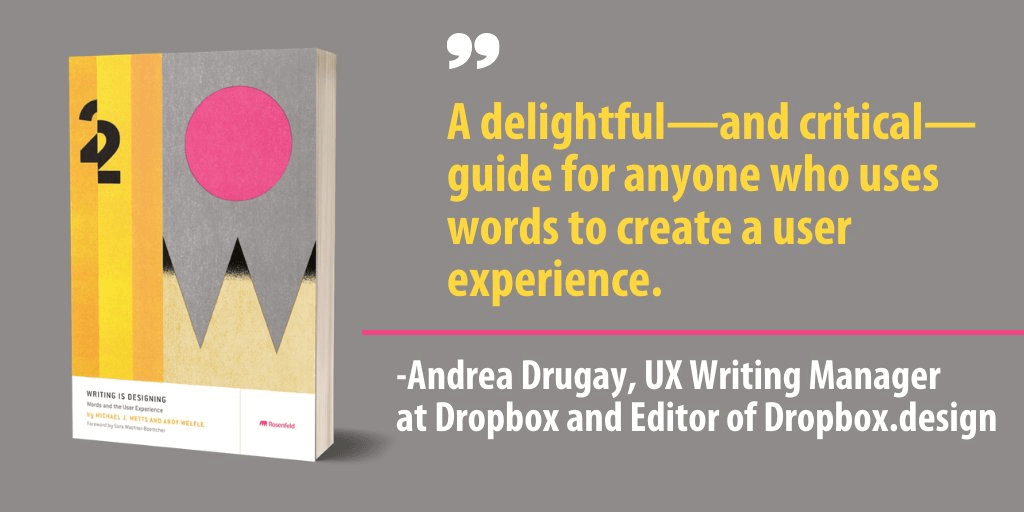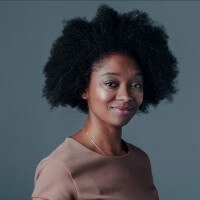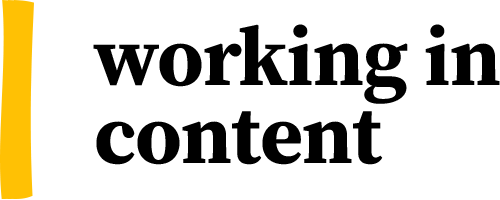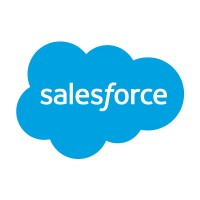On this page:
- Career history, at-a-glance
- The Free Methodist Church: a first step into content and UX
- Moving on to a role at Wolfram
- Michael's first (and last) agency role
- Working on conversational experiences at Allstate
- Advice, recommendations and tips from Michael
- Michael J. Metts: Further reading, watching and listening
Michael J. Metts is co-author of the book 'Writing is Designing: Words and the User Experience', a speaker for global conferences and workshop facilitator, and the current Director of Content Design at Upwork. He's spent a large portion of his career working in the UX space for digital products.

Career history, at-a-glance
![Upwork logo]() UpworkDirector of Content DesignNov 2020 - Present
UpworkDirector of Content DesignNov 2020 - Present![Allstate logo]() AllstateUX ManagerApril 2018 - November 2020 (2 years, 8 months)
AllstateUX ManagerApril 2018 - November 2020 (2 years, 8 months)![The Nerdery logo]() The NerderySenior UX Designer/UX Writing LeadApril 2016 -- April 2018 (2 years)
The NerderySenior UX Designer/UX Writing LeadApril 2016 -- April 2018 (2 years)![Wolfram logo]() WolframLead UX Designer/WriterMay 2013 -- April 2016 (3 years)
WolframLead UX Designer/WriterMay 2013 -- April 2016 (3 years)![Free Methodist Church - USA logo]() Free Methodist Church - USAContent StrategistMarch 2011 - May 2013 (2 years, 3 months)
Free Methodist Church - USAContent StrategistMarch 2011 - May 2013 (2 years, 3 months)![Fiber Solutions Inc. logo]() Fiber Solutions Inc.Freelance CopywriterAugust 2012 -- April 2013 (9 months)
Fiber Solutions Inc.Freelance CopywriterAugust 2012 -- April 2013 (9 months)![Swift Car Care -- Bridgestone/Firestone logo]() Swift Car Care -- Bridgestone/FirestoneWebsite and marketingMarch 2010 -- March 2011 (1 year)
Swift Car Care -- Bridgestone/FirestoneWebsite and marketingMarch 2010 -- March 2011 (1 year)![Spring Arbor University logo]() Spring Arbor UniversityProduction AssistantAugust 2009 - December 2009 (5 months)
Spring Arbor UniversityProduction AssistantAugust 2009 - December 2009 (5 months)
We spoke at length with Michael about his career to-date, and his experiences as a UX writer, designer and strategist at various organisations. He also shared some great advice and tips with us about working in the field, as well as what to expect from a true UX practitioner role.
The Free Methodist Church: a first step into content and UX
After Michael completed a degree in Visual Storytelling, he aimed to find a job in journalism — however, relevant work proved hard to find. Local papers at that time were making multiple posts redundant to save money, so there was no ready entry-path for him to get his foot in the door. As a result, he worked at his father-in-law's auto repair shop in Chicago for a while.
With an established skillset in photography and writing, Michael eventually took up his first Content Strategist role in 2011; working for the Free Methodist Church - a large not-for-profit organisation comprising a denomination of churches.
"When I joined this organisation, they were in the middle of a website redesign, and I realised pretty quickly that they didn't need more content. They needed better content. They needed to use it better.
"My brother suggested that I read Content Strategy for the Web (by Kristina Halvorson), and I was like 'this is cool. This is what we need.' I approached my boss and asked if I could be a content strategist, and he was like 'oh, ok, well I can't pay you anything more, but you could call yourself that, whatever you want.' So, that's how I 'became' a content strategist."
Michael has a clear knack for process and follow through. He approaches his work in a clear methodical manner and just gets it done. His perspective on content strategy is practical and down to earth. Michael leads in such a way that you gain perspective on why content strategy should be important to you and your role.
source: LinkedInWith a website redesign project well underway, Michael was faced with the challenge of bringing together many different organisations. As things stood, each one had its own funding, and each one had been doing their own thing with the website — all in total isolation from one another.
"It was hilarious. Our team was remote, but all these departments were literally working in the same building and they all had a completely different design and a completely different approach to content. So if you clicked around the website, you really couldn't find your way between departments."
One of the first things Michael and his colleagues did was create a 'unified' template, and a content model that could be used across all of these organisations.
What is a content model?
"A content model documents all the different kinds of content you have on your website. It breaks content types down into their component parts, describes them in detail, and maps out how they relate to one another.
"A content model is an important step in working out the finer details and practicalities of how you write and manage your content, and how you will present it on the page. If you're building a new site or refreshing an existing one, it's a vital part of that process."
At the time, the concept of 'content modeling' was a fairly new one, and Michael spent time reading up on what more well-established people in the industry were doing in this space; people such as Content Strategists Karen McGrane and Sara Wachter-Boettcher, and Digital Strategist Jeff Eaton. This gave him enough information and insight to develop a content system which was adaptable and more user-friendly. He then successfully sold it in to the rest of his organisation.
"At the time, it was like I was just getting my feet wet with UX. I did a lot of UX 'things' like wireframing, writing, prototyping and user interviews - all that stuff. And I really encourage people new to UX to think about starting out in a not-for-profit organisation. You can just 'do' the work - don't ask permission, just do it, you know? Because then, you can literally try anything and you get to learn, you get to exercise those skills for your portfolio, but you also learn a bit about what you want to do more of."
Moving on to a role at Wolfram
Michael was determined to find a UX-dedicated role for his next position, but the industry landscape at that time mean that many jobs he was being interviewed for were just not matching with his own expectations:
"In Chicago, it was hard to find UX roles that weren't just about creating visual deliverables day in and day out. And that was hard for me to reconcile with what I was reading about UX. I'd been reading that it was about identifying and solving user problems or meeting user needs or identifying opportunities. It was frustrating because I'd go into interviews and it would go poorly; all they wanted to know about was whether I've used the 'latest tool' or not."
He eventually found a role at Wolfram as a Lead UX Writer, working in a team of designers who didn't seem as confident in their writing abilities as Michael. They needed help to devise written components such as snippets of text (what would come to be known in the industry as 'microcopy').
What is microcopy?
"Microcopy is the term for the small bits of copy on an app's interface that help users 'do stuff'.
"Microcopy examples are error messages, contact form explainers, ecommerce hints. At a glance, these tiny clusters of words seem insignificant when compared to the overall app design. But surprisingly, those tiny words have a huge impact on conversions."
"If they had error messages or button labels or flows that they needed to write, I would partner with them and help them figure out what to do. And I just kept asking questions like 'why is it this way?' And 'what comes before this?'
"I've never seen the two things (visual design and words) as different or distinct - it's right there in the title of the book that I wrote with Andy Welfle; 'writing is designing', right?
"But for a lot of people, it's just not second nature. I know I've had to carve out that space in every role I've been in so far, too."
Eventually, Michael's role became Lead UX Designer and Writer at Wolfram. At the same time, he moved into a more senior 'standing' at Wolfram when his co-worker Scott Kubie (now independent and doing contracting work) left the organisation.
Michael is a thoughtful and skilled designer, writer, and facilitator. Chief among his many strengths are listening and empathy. He excels at understanding the human issues behind business problems, and does a fantastic job of making people feel heard. This is incredibly important on digital projects, where so much of the work is a form of change management.
source: LinkedInHis first (and last) agency role
In 2016, Michael moved to his first agency role -- Senior UX Designer and UX Writing Lead at The Nerdery. It gave him the opportunity to lead on something different there; the perspective of UX and the practice of UX writing.
"I would teach about UX and UX writing throughout the agency, and to our clients. You quickly become a representative of what can be done, when you think about writing from a product perspective.
"I think one of the neat things about working at an agency was the rapid exposure to different things that you get. Because someone will be like, 'ok, you have 30 hours to do an information architecture for this website'. It's so intense and fast-paced."
Michael also liked the fact that it was his first time being part of a large community of designers (c.60 of them!). However, he states that really everyone there was a generalist - all wearing different hats.
"We were trading tips and secrets a lot. And then there were some people who were passionate about research, and good at it, so they would be trading tips and training the rest of the team. We all learned from each other."
Working with Michael has had an immeasurable positive impact on my personal growth because he is an inspirational design mentor and talented leader. I've often found myself in awe because Michael seems to know what to do in every situation. He can look at or listen to a problem and without a doubt he will ask questions, come up with a creative and thoughtful solution, and present it in an extremely beautiful way.
source: LinkedInNowadays, his general view on agencies is an interesting one:
"I feel like the world has kind of moved on from agencies a bit, you know. They're still out there for sure, making money, etc, but essentially, I think we're at a place now where lots of companies realise that, for example, they're 'a software company', and this has led to so many good opportunities with in-house teams growing their own practices.
"You can be so much more influential, in-house. That's what I really appreciate."
Working on conversational experiences at Allstate
Two years later, in April 2018, Michael moved into a UX Manager position at Allstate, an insurance company. It was a role geared primarily around 'conversational experiences/design'; a UX concept which only a small proportion of organisations were embracing around this time.
His remit was to apply this concept to many different channels at Allstate, as the designated lead in the organisation - from the IVR phone systems to multiple chat products:
"...And I was put into a management role a couple of months after joining and I helped step up those teams. I helped establish how we were going to work together, and how we would document our designs, what kind of principles we'd be shooting for, and what kind of reusable patterns we would use. This was in addition to working every day with a scrum team."
He learned a great deal about the world of conversational AI whilst he was there; seeing it as a kind of 'union' of the two skills he'd always thought went together so well; writing and design.
"These two things are really complex - they're not easy. And it's funny because we don't realise how much of the ways of working we've developed in UX and development, even things like a scrum team; those things all depend on a screen-based interface.
"We'd be told the typical numbers you should have of engineers, all handled in like a very 'big company' way, but the reality actually was that you needed to have five engineers and one designer and one product person in a project. And this would flex depending on what needed doing.
"I've learned a lot about how hard it is for sure. There's just so much in-depth work needed in that space. It was a really great experience though, and one thing that really stuck with me is that people really think this work is kind of straightforward and simple -- but it's definitely not!"
Michael's job was quite varied. It could involve writing first drafts of scripts, putting together flows that showed logic of how these systems would work, sharing this kind of work with UX leadership. But invariably, each morning involved a stand-up meeting (aka scrum meeting), and often included colleagues from regions such as Asia Pacific and Europe.
"There were usually many, many meetings like that. And, throughout the week, I'd be scheduling critiques for the team, and facilitating those. I'd usually be the person bringing more things to these meetings than anyone else, because I wanted to lead by example. I'd bring a lot of my own work to these meetings and received a lot of feedback from other conversation designers and the UX folk on it."
Michael also worked closely Allstate's product team on a regular basis:
"I really tried to build strong relationships with the product team members - every step of the way. We would have meetings twice a week so I could check in with them and their goals."
A notable amount of his time was spent building and scaling up different teams, too. And with the trust and support of his line manager, he even extended his work to redesigning the hiring process at the company; creating more 'alignment' in terms of candidate requirements and putting processes in place which mitigated against bias as much as possible.
Advice, recommendations and tips from Michael
What do you regard as your most personally rewarding piece of work?
"Probably discovery work -- which came nearer to the end of my time at Allstate. They were looking at what to build in the future and were really supportive of the idea of using a lot of design thinking methods and using user-centered approaches to try and work this out. So, we did a week-long exercise of collaborative journey-mapping, using the design studio to sketch out ideas, creating a simple prototype and testing it.
"And to me, it was astonishing how much language was a part of that; content, writing... you can't really express a new business idea without writing. It can't just be shapes and a prototype. So the whole thing was a really good fit for me, and a really enjoyable, interesting cause."
What advice would you give other content people who want to achieve similar accomplishments to yourself?
"Be loyal to you. That's hard to remember when you're in the midst of it and you care about the people you're working with - and you want to see the company succeed.
"I'm not saying don't do those things, but it's really important that you take care of you, that you keep your portfolio developed, that you share your work so people know what you do - so that you're set up for success, long-term.
"And in regard to the role, there's not a lot of writing involved - maybe 10%. Instead, you're spending most of your time building relationships and doing research to understand user needs. So, keep that in mind, and learn as much as you can about design as well as content.
"Finally, remember that your work is valuable. When I talk with content people around the world, I think things are getting better. But in a lot of organisations, content practitioners are still being undervalued, even though they have 90% of the same skills as the visual designers. So that's something that can really weigh on you.
"Just remember that your work is valuable, even if it appears to be currently undervalued in the organisation you're working at."
If you could go back in time and give yourself a piece of personal advice early in your career, what would that be?
"Don't assume that you're an advocate for users, just because you have 'user' in your job title.
"I think, early on, I was like 'oh well, I am the user advocate, and I know about the users...'
"I had some skills that could help a team 'get there', but far too often I was in a position where I was maybe condescending towards a team, to be honest - about what they knew about user needs and wasn't collaborative enough.
"So, that's why I focus so much more on 'collaboration' now - because I realised that it's wrong of me to assume. Instead, you need to help everyone on the team understand what people are going through and how you (as a group) can help them. That's what you should be doing with those skills; not making yourself 'feel better'. That's one thing I still tell myself, for sure."
Which industry professionals should people be following right now on Twitter?
 Gladys Diandoki Enthusiastic French UX writer --- Storyteller for a living and for fun --- She/herFollow @Gladysdit
Gladys Diandoki Enthusiastic French UX writer --- Storyteller for a living and for fun --- She/herFollow @Gladysdit Candi Williams Content Design Manager & Strategist by day. Author by night. Fan of purposeful words, inclusive design, pineapple stationery and wine.Follow @candiwrites
Candi Williams Content Design Manager & Strategist by day. Author by night. Fan of purposeful words, inclusive design, pineapple stationery and wine.Follow @candiwrites David Dylan Thomas Big fan of treating people like people. Author, Design for Cognitive Bias. Content Strategy Advocate, @thinkcompany. Speaker, Lots of Places.Follow @movie_pundit
David Dylan Thomas Big fan of treating people like people. Author, Design for Cognitive Bias. Content Strategy Advocate, @thinkcompany. Speaker, Lots of Places.Follow @movie_punditIf you could choose one book to recommend to someone early in their career, what would it be?
 Algorithms of Oppression: How Search Engines Reinforce Racism
Algorithms of Oppression: How Search Engines Reinforce RacismSafiya Umoja Noble challenges the idea that search engines like Google offer an equal playing field for all forms of ideas, identities, and activities.
— Michael J. MettsMichael J Metts: Further reading, watching and listening
- Michael's website The site hosts some of his blogs, as well as information about the workshops he runs with Andy Welfle.
- Michael's book: Writing is Designing: Words and the User Experience Co-authored with Andy Welfle.
- Content Strategy Insights, Episode #58 Michael (and Andy Welfe) speaks to fellow content strategist Larry Swanson on this podcast.
- Writing is Designing webinar Michael (and Andy Welfe) presents on the 'writing is designing' theme for Content Strategy Philly.
- Content Strategy Q+A: What is accessible content? Michael talks about why accessibility is important in this quick video for Writer.
- UX Writing Worldwide Report 2020 Michael is a featured interviewee in this recent report.
- Practical content strategy: Making the journey Article for GatherContent, where Michael runs through the 4 C's of practical content strategy.
Michael is currently hiring for Senior Content Designer @ Upwork




















